“You cannot hope to build a better world without improving the individuals. To that end, each of us must work for his own improvement and, at the same time, share a general responsibility for all humanity, our particular duty being to aid those to whom we think we can be most useful.” -Marie Curie
There's nothing like looking into the deepest mysteries the Universe has to offer, and trying to come up with the explanation and understanding we can based on all the available data. That's what we're all about here at Starts With A Bang! It's less than two weeks until my talk at the May 24th event: Astronomy On Tap, at Peddler Brewing Company! Join me if you can, and I promise it'll be a great time as far as making you wonder about the Universe goes! There's a lot coming up, but don't forget to look back at what we’ve covered in this past week:
- How far is the edge of the Universe from the farthest galaxy? (for Ask Ethan),
- Hubble views the final frontier for dark matter (for Mostly Mute Monday),
- The scientific truth about Planet Nine, so far,
- 5 reasons why the 21st century will be the best one ever for astrophysics,
- What if cosmic inflation is wrong?, and
- Spectacular new Crab Nebula images close in on its final secrets.
As always, there's more science than we're able to talk about, so let's see what extra things you can draw out as we jump into this latest edition of our comments of the week! Let's start with our ongoing conversations from last week...
From Denier on what to do (or not do) about climate change: "perhaps the political action taking place is the correct action given *ALL* of the available knowledge (economic, societal, and physical science).
[...]
"However it is a problem that is solving itself for all the reasons I laid out which you apparently couldn’t find issue with."
[...]
"Dr. Roy Spencer *DOES* believe the Earth’s climate is getting warmer. The particular label he’s been slapped with is a ‘lukewarmer’."
[...]
"I certainly didn’t personally attack the man the way you just did Dr. Roy Spencer."
You have painted an incorrect picture in many ways. First, you are incorrect about the physical science, and Roy Spencer's role in accepting it, and the indications of Roy Spencer's data. In 1990, Roy Spencer published results showing no warming in the upper atmosphere from the UAH dataset. It disagreed with all predictions and with other measurements. The overwhelming majority of climate scientists claimed there must be something wrong with his calibrations. He responded by, for the next 24 years, impugning them as irresponsible, bad scientists, and making claims that the true warming due to human effects is negligible. You can find some sources on this here, here and here. He claimed, as the graph you presented (above) shows, that the upper atmosphere isn't appreciably warming, and therefore an anthropogenic cause to global warming is disfavored.
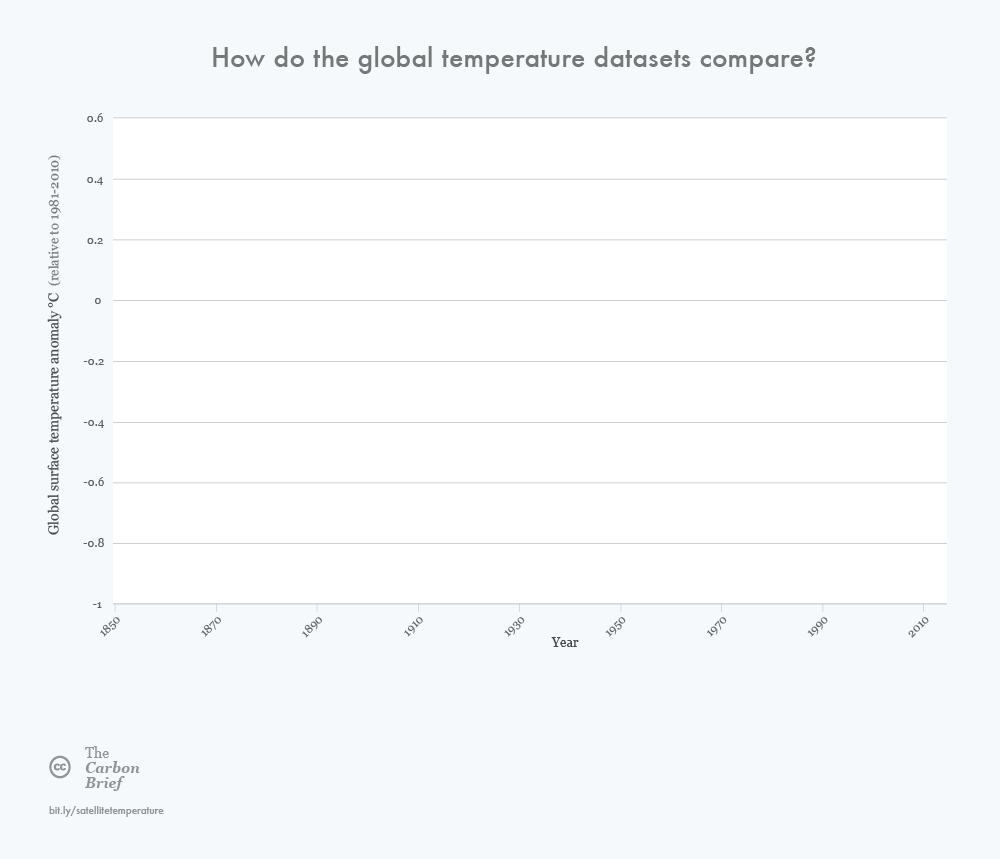 This is what the calibrated satellite data (RSS and UAH) looks like, along with surface data. Image credit: Rosamund Pearce, Carbon Brief.
This is what the calibrated satellite data (RSS and UAH) looks like, along with surface data. Image credit: Rosamund Pearce, Carbon Brief.
Then, in 2014, the truth came out: Spencer's UAH team had made a huge mistake in the calibration of their data. Instead of negligible upper-atmosphere warming, they found that the upper atmosphere had been warming at +0.14 degrees per decade, double the 1880-2014 rate of 0.07 degrees per decade. Spencer's response has been to go from outright denial to mere misinformer. Why are you showing the incorrectly calibrated data as "proof" of your claims? My theory is that you are wrong on the science and you know it, yet you refuse to change your conclusions because you do not like their implications. So what about about "the political action taking place?" There is none. There is nothing regulating carbon dioxide in the United States, period. There are proposals, all of which would be better than the "none" in place, including:
- cap and trade (the worst option, IMO),
- a carbon tax (i.e., putting a price on carbon), heralded as a free-market solution to climate change,
- or the carbon fee and dividend policy.
I think even the worst option of these would be better than the current do-nothing policy, which includes subsidies and incentives for carbon polluters. The problems are not solving themselves. You have not presented alternative numbers to the ones I gave, you merely made sweeping and unsupported statements. Global CO2 rates will not go down without tremendous technological breakthroughs or legislation penalizing CO2 emissions. Population will trend upwards and plateau at the century's end according to all projections, landing at 10-12 billion people on Earth. The climate is changing more and more dramatically than it needs to; a small policy change can have a big environmental and societal impact, while having a small negative (or even positive) overall economic impact. Think about it.
From Jonathan on spiral galaxies vs. elliptical galaxies: "Ethan, you wrote this about elliptical galaxies and spiral ones: “The inner regions of spirals and ellipticals are comparable in densities, but the outer regions are where ellipticals are significantly richer in stars.” Surely this would mean that ellipticals are *more* dense than spirals."
Now, let's get away from the never-ending climate debate and let's take on the Universe! Ellipticals, in general, are larger and more massive than spirals. In the innermost regions, ellipticals and spirals are comparable in density. This means, in the innermost, say, 10-50 kpc, they have similar densities. But if you go out to 100 kpc, 200 kpc, 400 kpc, or more, spiral galaxies typically have some gas and no stars. Ellipticals, though, have significant populations of stars. Not as much as the inner regions, but there are stars present. Overall, the density of an elliptical is lower than that of a spiral, due to its much larger overall volume, and those large regions of lower overall density. But the number of stars and the density at every radial distance is larger for ellipticals than spirals.
I hope that clears things up!
From Outtatheblu on the Universe's first black dwarf: "I am curious about the dark star’s properties when it finally cools down. Assuming no further accretion, it’s mass and size should be roughly the same order of magnitude as it is currently (im unsure how much mass it would lose through its EM radiation from now until it cools). Once the plasma cools and stops emitting light, would there be a (solid?) mass left over with similar neutron-star level density?"
Don't underestimate gravitational contraction; it's plausible that it will have the same mass (to within less than 1%, which comes from energy loss due to E = mc^2) but its radius may be up to around 20%-50% smaller. The mass left over would be held up by degeneracy pressure (thanks to the Pauli exclusion principle), where it's electron degeneracy for black dwarfs and nucleon degeneracy for neutron stars. But black dwarfs would have roughly white dwarf-level densities, which is only about one-millionth that of neutron stars.
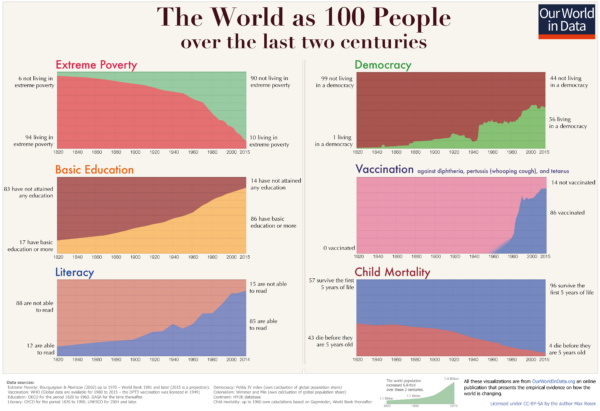 Major graphs concerning our world, demographically, as it's changed over the past two centuries. Image credit: Max Roser / Our World In Data.
Major graphs concerning our world, demographically, as it's changed over the past two centuries. Image credit: Max Roser / Our World In Data.
From CFT on the anti-global-warming train: "How can he honestly claim that temperature readings taken from actual measurements from balloon and satellites are ‘bad data’ in comparison to utter ‘non data’ forcasts generated by computer models based on….theory?"
He doesn't. He claims that uncalibrated or incorrectly calibrated data is 'bad data' in comparison to correctly calibrated data.
And he's right.
There are many ways that being alive today is better than at any point in the past, as the data clearly shows. But that doesn't mean there aren't genuine problems facing the world, and that's definitely no excuse for being dishonest about those problems. Your opinion carries no weight in matters of fact, nor does mine or anyone else's. But all of our opinions matter in making policy and in our public statements, which influence others around us. If we take counterfactual 'opinion' stances then we are misleaders at best and wholesale liars at worst. We must be better than that. Even when the data leads us to places we'd rather not go, we must go there. Anything less is a lie.
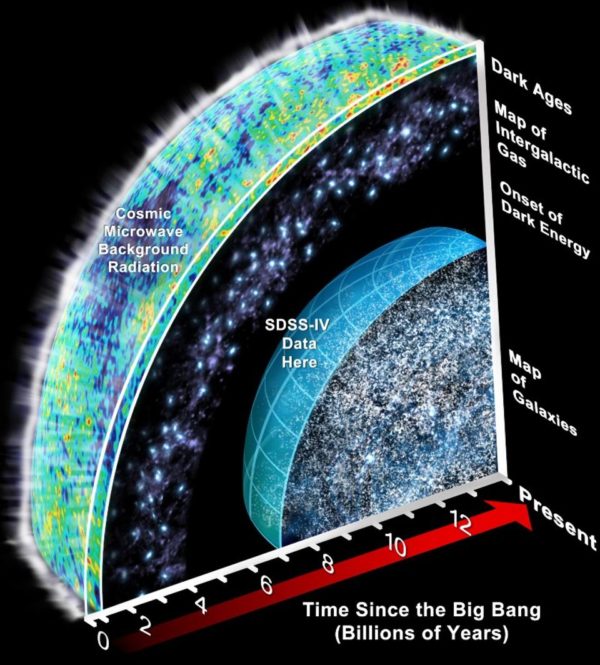 Our deepest galaxy surveys can reveal objects tens of billions of light years away, but even with ideal technology, there will be a large distance gap between the farthest galaxy and the Big Bang. Image credit: Sloan Digital Sky Survey (SDSS).
Our deepest galaxy surveys can reveal objects tens of billions of light years away, but even with ideal technology, there will be a large distance gap between the farthest galaxy and the Big Bang. Image credit: Sloan Digital Sky Survey (SDSS).
From John on the distance from the farthest galaxy to the Universe's edge: "Thank you. It’s good to be reminded of the different expansion rates at different times since the end of inflation. The influence of time on the universe is easy (at least for me) to underappreciate."
You have to remember that the expansion of space started out very, very fast, and dropped precipitously over time. Today, it's down at around 70 km/s/Mpc, and it will level off to a constant of about 50 km/s/Mpc due to dark energy. But in the past, when the Universe was smaller, the matter density was greater by a factor of a^(-3), where a is the Universe's scale factor (taken to be 1 today by convention). When the Universe was half its size, the matter density was eight times as great, and the expansion rate fell off as a^(3/2). When the Universe was very, very small, radiation dominated, and radiation density was greater by a factor of a^(-4), and the expansion rate fell as a^(2). Here, look at this graph:
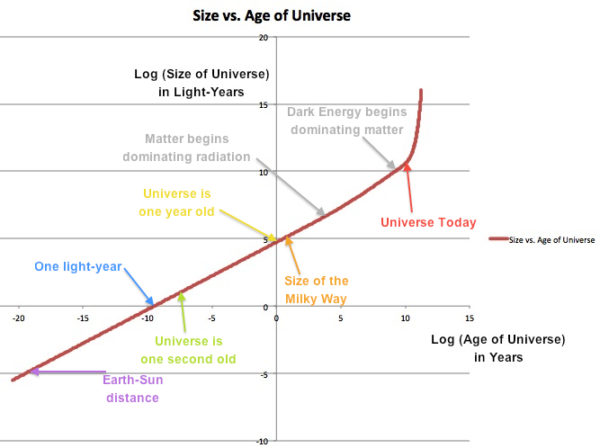 The size of the Universe (y-axis) versus the age of the Universe (x-axis) on logarithmic scales. Some size and time milestones are marked, as appropriate. Image credit: E. Siegel.
The size of the Universe (y-axis) versus the age of the Universe (x-axis) on logarithmic scales. Some size and time milestones are marked, as appropriate. Image credit: E. Siegel.
There are three different "slopes": the "radiation" slope (until matter dominates radiation), the "matter" slope (until dark energy dominates), and then an exponential growth rate once dark energy dominates. Note the extrapolation into the future, and how dramatically the Universe grows. It's those last few logarthimic "moments" that matter most. When the CMB was emitted (at about 10^5.5 years), the Universe was about 10^8 light years (100 million light years) across. That's a big number, but not that big. Today, the CMB is located about 900 million light years from the edge of the observable Universe; everything continues to expand. Never forget!
From Steve about this graph: " I take it that on the timeline our galaxy is essentially at the edge of the universe."
Nope; we are, from our perspective, at the "Universe today" mark, and we measure outwards from our location and backwards from our time. As far as we are concerned, we place ourselves at the "origin," not the edge.
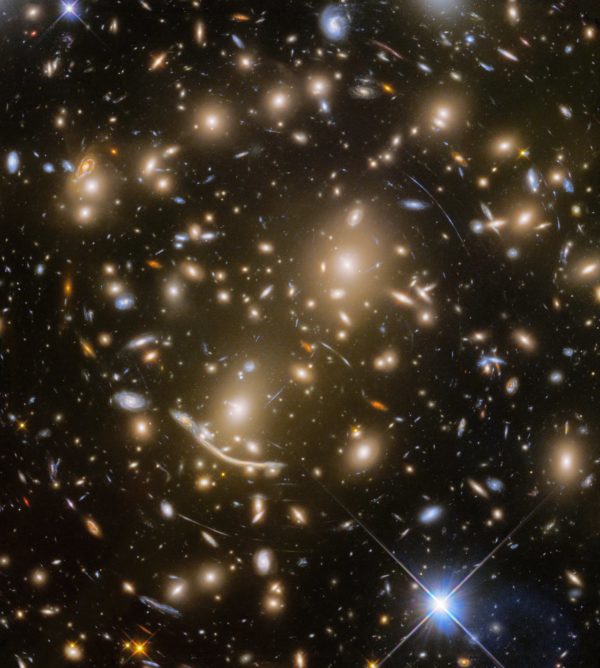 The streaks and arcs present in Abell 370, a distant galaxy cluster some 5-6 billion light years away, are some of the strongest evidence for gravitational lensing and dark matter that we have. Image credit: NASA, ESA/Hubble, HST Frontier Fields.
The streaks and arcs present in Abell 370, a distant galaxy cluster some 5-6 billion light years away, are some of the strongest evidence for gravitational lensing and dark matter that we have. Image credit: NASA, ESA/Hubble, HST Frontier Fields.
From anneb on whether galaxy clusters prove dark matter: "Dark matter was invented to explain these lensing effects, but invented matter is not the same as discovered matter. Some theorists claim dark matter doesn’t exist at all and these lensing effects are caused by something else."
First off, dark matter was not invented to explain these lensing effects; it was invented for a completely unrelated gravitational purpose: the speeds of individual galaxies within clusters. That one "invention" has many, many observational consequences, and the magnitudes of strong and weak lensing are two of them. So are galactic rotation curves, fluctuation patterns in the CMB, the large-scale power spectrum of the Universe, baryon acoustic oscillations, dark matter filaments, and many others. You are correct: some people will only be convinced by a direct detection of a dark matter particle; anything less will be unconvincing. But until you can invent a "something else" that does just as good for the full suite of data, dark matter will remain the leading idea.
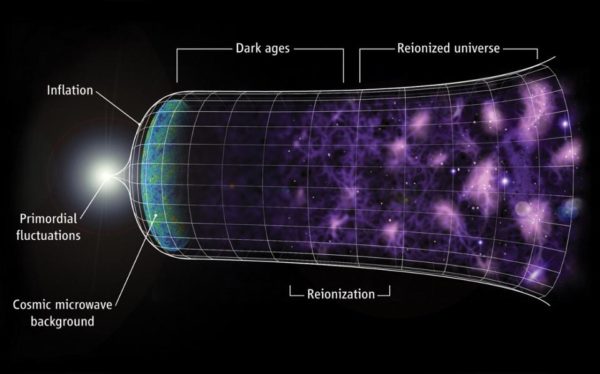 The expanding Universe, full of galaxies and complex structure we see today, arose from a smaller, hotter, denser, more uniform state. Image credit: C. Faucher-Giguère, A. Lidz, and L. Hernquist, Science 319, 5859 (47).
The expanding Universe, full of galaxies and complex structure we see today, arose from a smaller, hotter, denser, more uniform state. Image credit: C. Faucher-Giguère, A. Lidz, and L. Hernquist, Science 319, 5859 (47).
From Douglas Watts on the age of the Universe: "The Standard Model doesn’t seem to prohibit a Universe of age 1 Trillion years (72 of ours stacked together). At a quintillion maybe proton decay might have an effect … but so what. Is the 13.8 GY age of the Universe simply stochastic?"
The age of the Universe isn't randomly determined; it simply "is." We measure the expansion rate today, the composition of the Universe today, and extrapolate backwards. That's where the 13.8 billion year figure comes from.
Now, are you asking, "what does the Universe's age need to be to permit an Earth-like planet around a Sun-like star with enough time for a human being to evolve on it?" If so, the answer seems to be at least 5-7 billion years, and that it could happen trillions of years in the future. But there is some non-infinitesimal, significant, and arguably large probability that the answer of "around now" is a pretty good one. In that sense, the 13.8 billion years we have simply "is."
This artistic rendering shows the distant view from Planet Nine back towards the sun. The planet is thought to be gaseous, but smaller than Uranus and Neptune. Hypothetical lightning lights up the night side. Image credit: Caltech / R. Hurt (IPAC).
From Jason on hunting Planet Nine: "From my understanding, telescopes in general can only see what the human eye can see. [...] Is it possible that next generation optics will be able to provide a better view of that area of space, and thus provide more context to the evidence (or lack there of) of the existence of Planet Nine?"
Telescopes can see much more than the human eye can see: they can see wider ranges of wavelengths, they can see far fainter objects, and they can see resolutions way beyond what our eyes can. Now, for a distant planet, you have to remember that brightness falls off as 1/r^2, which means the amount of sunlight striking planet nine is very small compared to the amount striking Neptune, and then the reflected light must make the return journey, which also sees the brightness fall as 1/r^2. Pan-STARRS hasn't seen Planet Nine because the magnitude of Planet Nine is too faint. Better optics won't help much; we already capture 80%+ of the light that's out there. But larger-aperture telescopes will help, and wide-field views with long integration times will help. What an 8-meter telescope can do in an hour, a 30-meter telescope can do in about 4 minutes, and with better resolution. It's not the optics, but the size and field-of-view, that must improve.
Illustration of the density (scalar) and gravitational wave (tensor) fluctuations arising from the end of inflation. Image credit: National Science Foundation (NASA, JPL, Keck Foundation, Moore Foundation, related) – Funded BICEP2 Program.
From Frank on the nature of gravity: "Isn’t it possible gravity is not a force but just bending of spacetime?"
No matter what its nature is, gravity is just as surely a force as anything else. What we can observe and measure is more important than what you conclude its "true nature" is. What you are asking is if gravity must be a quantum force at some level. Let me ask you this question: what happens to the gravitational interaction of an electron as it passes through a double slit?
If the answer is to be anything other than "nonsense," gravity must be a quantum phenomenon, inherently. We currently have no idea how we'd interact with a graviton to detect its nature directly, but detecting gravitational waves from inflation would also prove it, since there is no way to generate them without gravity being a quantum phenomenon. There is hope for this, observationally, after all.
From Denier on the 21st vs 20th century: "I’m sure we’ll learn some new stuff in the 21st Century, but ‘best one ever’? Better then Einstein? You really think that?"
The 20th century saw some tremendous scientific achievements, no doubt. You listed a great many of them yourself in your comment. But how many of them are astrophysical achievements, as opposed to aeronautics, aerospace, particle physics, etc.? I think the 21st century will be poor for particle physics and aeronautics, good for aerospace, but great for astrophysics. The Universe is a vast and strange place, and even with all that Hubble has done, we've only uncovered a tiny fraction of what's really out there. For what we know and what we are capable of, unless we fail to fund astrophysics, I have little doubt it will turn out to be an incredible century that will surpass the 20th in a great many ways.
How cosmic inflation gave rise to our observable Universe, which has evolved into stars and galaxies and other complex structure by the present. Image credit: E. Siegel, with images derived from ESA/Planck and the DoE/NASA/ NSF interagency task force on CMB research. From his book, Beyond The Galaxy.
From Sinisa Lazarek on the joys and perils of inflation: "...if inflation is correct, and some day we get some more solid notions of the conditions that ought to have existed in order for inflation to occur (assuming inflation in itself is not “the default” state), then we might be able to shed some more light on what the things that preceeded it might have been.
But just by reversing the clock so to speak.. we get to inflation and all prior history is erased"
Inflation, by its nature, wipes out anything that came before it. But when we look back at our Universe, the final 10^-33 seconds (or so) of inflation do leave their cosmic imprint on the Universe. There are additional predictions that arise that may yet be confirmed, including: spatial curvature at the ~10^-5 level, a rolling scalar spectral index at the 0.1% level, and primordial gravitational waves at the non-zero level. As our observations of the original light in the Universe, the CMB, continue to improve, we just might find this evidence.
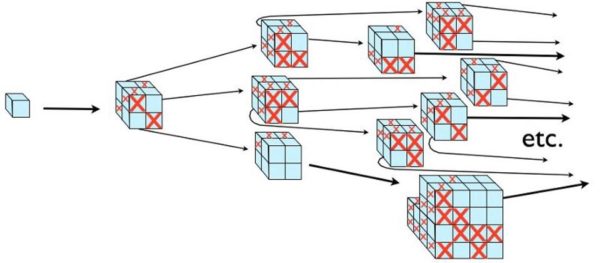 Even though inflation may end in more than 50% of any of the regions at any given time (denoted by red X’s), enough regions continue to expand forever that inflation continues for an eternity, with no two Universes ever colliding. Image credit: E. Siegel.
Even though inflation may end in more than 50% of any of the regions at any given time (denoted by red X’s), enough regions continue to expand forever that inflation continues for an eternity, with no two Universes ever colliding. Image credit: E. Siegel.
From Cleon Teunissen on probabilities and likelihoods in inflation: "Ijjas, Steinhardt and Loeb have pointed out that as the depth of understanding of inflationary models has increased, more and more problems have arisen. The way I understand it: IS&L have for example pointed out that it is now understood that once inflation starts the overwhelmingly probable course of events is that the inflation continous forever. As I understand it: while it is _possible_ for inflation to end, that is an exceedingly improblable outcome."
The thing is, we have no way of measuring or calculating what the probability of many things are in inflation. If something has an infinitesimally small probability of occurring, we're kind of screwed, and Ijjas, Steinhardt and Loeb are correct. But if there's a finite, non-zero probability, and we have many realizations, we're fine, and the IS&L argument holds no water. What you are seeing, above, is an example of "eternal inflation," where it continues for an eternity, but has a ~50% probability of ending at every stage. This doesn't pose any problems for our Universe, even though the overwhelming majority of phase space (the space of possible outcomes) at any given time consists of inflating spaces rather than non-inflating ones. If an inflationary model that gives our Universe has a non-zero, finite probability of occurring, we, too, are fine.
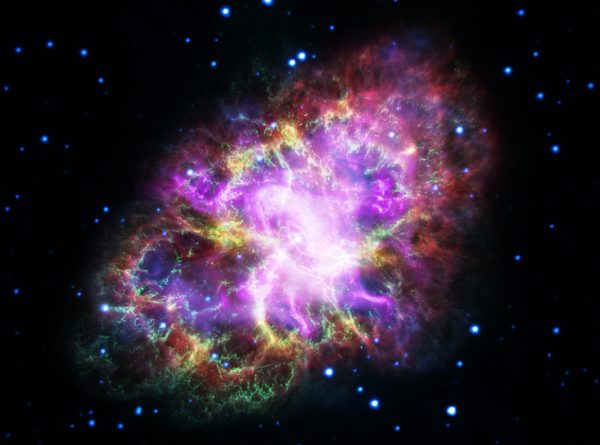 A combination of images from radio, infrared, optical, ultraviolet and gamma-ray observatories have been combined to create this unique, comprehensive view of the Crab Nebula: the result of a star that exploded almost 1000 years ago. Image credit: NASA, ESA, G. Dubner (IAFE, CONICET-University of Buenos Aires) et al.; A. Loll et al.; T. Temim et al.; F. Seward et al.; VLA/NRAO/AUI/NSF; Chandra/CXC; Spitzer/JPL-Caltech; XMM-Newton/ESA; and Hubble/STScI.
A combination of images from radio, infrared, optical, ultraviolet and gamma-ray observatories have been combined to create this unique, comprehensive view of the Crab Nebula: the result of a star that exploded almost 1000 years ago. Image credit: NASA, ESA, G. Dubner (IAFE, CONICET-University of Buenos Aires) et al.; A. Loll et al.; T. Temim et al.; F. Seward et al.; VLA/NRAO/AUI/NSF; Chandra/CXC; Spitzer/JPL-Caltech; XMM-Newton/ESA; and Hubble/STScI.
And finally, from Anonymous Coward on the greatest mystery of the Crab Nebula: "Do other known supernova remnants out there exhibit this same kind of mass discrepancy as the Crab Nebula, or is the problem unique to it?"
To the best of my knowledge, reconstructing the masses of other supernova remnants yields a similar problem. If you attempt to estimate the mass of the Cassiopeia A supernova remnant, you find ~1-2 solar masses of material in there, which doesn't make sense for a Type IIb supernova. However, there is the possibility that its hydrogen envelope was entirely stripped away, and so there's the possibility that there's an outer shell we haven't yet discovered that contains additional mass. This may be the case for the Crab Nebula too; finding what's out there in the Universe is a much harder task, given our instrumental limitations, than theorizing about what ought to be there!
Thanks for a great and thoughtful week, everyone, and I'll see you back here tomorrow and all of next week for more Starts With A Bang!

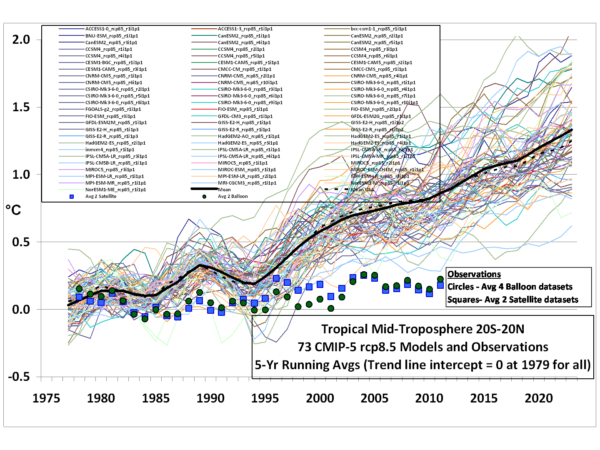
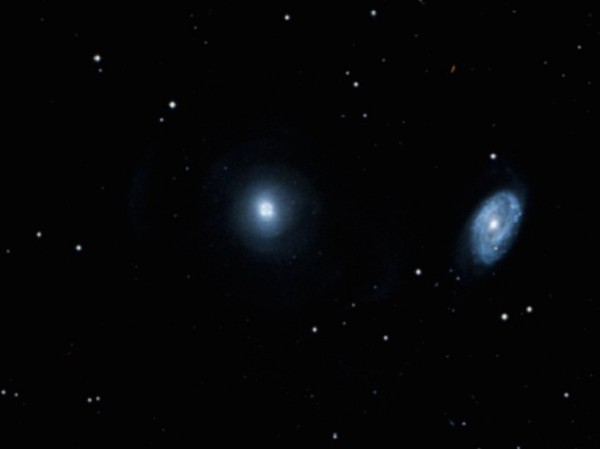


Your response is a giant ball of FAIL that I'm going to have to break up into bite sized pieces. I believe the driving issue is that your worldview seems to be divorced from reality. Let me give you a quick example:
@Ethan’s worldview:
Here is Reality:
Reality makes it awkwardly clear that Ethan worldview is politically motivated nonsense. The strangest thing is watching the scientist part of Ethan which recognizes reality battle with the ideologue part that refuses contrary evidence.
At the time I was thinking “Holy Crap!!! Ethan just absorbed some real facts and his needle moved!”. Now I’m thinking that it was just Scientist Ethan in charge of your typing fingers on May 7 because just one week later it’s now back to ignoring facts to claim once again that new legislation penalizing CO2 is the only way to avoid rising global CO2 emissions. Another noteworthy u-turn was this one:
According to “all” projections, eh? You know that isn’t true because you noted a population projection on April 23, 2017 that stated population “will peak at around 9 or 10 billion worldwide, which will happen likely sometime about 40 years from now”. When I Googled ‘global population peak’ the very first result came back with:
Ethan, when you say something that you know isn’t true that is called a lie. You lied. Yes, there are projections as high as you say and others even higher but that is not “all projections” and you know it because you yourself stated right here on this blog that you found a lower projection. You knew there were lower projections in existence, you pretended they didn’t exist, and you lied to people who trust you.
@Denier
When I Googled ‘global population peak’ the very first result came back with …
When I Googled ‘global population peak’ the very first result came back with:
The median estimate for future growth sees the world population reaching 9.7 billion in 2050 and 11.2 billion in 2100
https://en.wikipedia.org/wiki/Projections_of_population_growth
@Ethan,
Ah. So when the actual temperature record data does not agree with your computer climate model (which model you REALLY don't say, do you?), it isn't 'calibrated' correctly. Good to know the new terminology for 'tampering with temperature data', I see you are taking lessons from Michael Mann for the 'cause'. Quite a bit of that has been going around lately...strangely selective process this 'calibrating'. It seems to adjust historical temperatures whenever it suites them...that and claiming fabricated data in 'modeled' averages is valid as actual temperature readings...and that in 2016 up to 42% of their monthly station data was missing...so they made it up, and then claimed it really didn't matter. Considering that certain rent seeking warmists are quibbling over fractions of a degree in warming...yeah it matters, especially in how trends are analyzed.
.
https://realclimatescience.com/100-of-us-warming-is-due-to-noaa-data-ta…
.
I have no doubt the climate changes, I have never denied it. I have no doubt that the climate has warmed between every ice age, and will most likely continue to alternate between warming and cooling as long as the earth continues to orbit and sun is there. I have tremendous doubts about social advocate scientists who think they can make up..., excuse me, 'model' temperature record data and use it in their climate models as if it was actual temperature data from actual weather stations. I'll be sure to run that one past a few college physics instructors about how unnecessary actual measurements from instrumentation are when you can just imagine what that data is supposed to look like...according to your predetermined conclusions.
.
https://judithcurry.com/2017/01/20/a-case-study-of-the-norther-colorado…
.
Yeah, Dr. Judith Curry actually wrote about it too, that heretical 'anti-science woman' who dared to question the adjustments being made instead of acting like a political sycophant such as yourself. Much unlike you, she actually has a grasp of how statistical manipulation is being employed for reasons that have very little to do with science.
@Ethan wrote:
Here I can’t figure out if you are naively blurting details that don’t actually support your contention or doing it purposefully. I’m going to give you the benefit of the doubt and go with your not having a solid grasp of the history of the debate. As you like to say, let’s agree on the facts.
Santer et al. 2003 contended that a tropospheric hot spot would be a “fingerprint of human effects on climate”. The Skeptic Community didn’t coin the phrase or initiate the claim. That was Benjamin D. Santer and company responsible for introducing that idea to the debate. It was cemented in place when as an author, Santer included in IPCC AR4.
The predicted tropospheric hot spot failed to materialize. The Santer proponents wanted to blame the data rather than admit the prediction was wrong, but it wasn’t there in UAH, or RSS, or NOAA raw, or even the radiosonde datasets. There was finally a paper in Sherwood and Nishant 2012 that claimed to find one but even that was ridiculously weak and nothing like the one B.D. Santer had predicted.
This is going back a little ways but you and I had a conversation on exactly why this was in CotW#105. The prediction was wrong because Santer’s model of the atmosphere was wrong. For reasons that to this day are not understood the relative humidity of the atmosphere has been falling with correlation to increases in CO2. Santer didn’t know that would happen. No one knew it would happen, and that is why the predicted tropospheric hot spot failed to materialize.
He may have impugned scientists at some point but he didn’t in any of the links you provided. He was arguing ideas against other ideas. Scientists do that. I only stopped on this point because once again I’m unsure if you’re doing something on purpose or out of ignorance.
Links #2 and #3 are economic arguments and commentary about the unreachability of mandating zero fine particulate matter in the atmosphere. I can only conclude that when you are referring to ‘warming due to human effects’ it is link #1 that you have in mind. It is about the evidence of UHI in the CRUTem3 dataset, which causes me to wonder if you know that UHI is warming due to human effects? Did you really not know that?
@Ethan wrote:
So dramatic! In reality it was a few hundredths of a degree difference. In 2014 they went to version 6 of their dataset. They do recalibrate, plainly announce what they’ve done, and do what they can to provide the best product they can. It is not a big deal. Every temperature dataset provider does this, not just satellite-based temperature dataset providers. The update made no appreciable difference at all. Even after the calibration Santer’s “fingerprint” hot spot still isn’t there because the humidity isn’t as high as predicted. It isn’t the data that is wrong. The model is bad.
‘http://www.drroyspencer.com/2015/05/new-satellite-upper-troposphere-pro…
I have to say that for someone who wrote that people should have “tremendous respect for the people devoting their lives to furthering our understanding of any aspect of the Universe” you don’t seem to walk what you talk.
@Ethan wrote:
This is just more of your new game of ‘attack the source’. My motivations matter not one wit. What I’m telling you is the scientific truth and I’m providing links to published research and/or giving you search terms so you can find your own confirming information.
It you want my true motive for backing up my contentions the way I do it is because I can see that although you’re very intelligent you’ve drank the Kool-Aid. Yes, CO2 is a greenhouse gas that warms via a well understood mechanism. Yes, humans are primarily responsible for warming the planet. The rest of it is poison. Getting you challenge your own notions, to spit out the poison, is virtually impossible.
For all the reasons I put forth in that TL;DR CotW#158 Post 16, global warming is a problem that is fixing itself. We did it and the effects are temporary but while the effects are here we should rejoice. The massive destruction of habitat we inflict on the planet via development is shameful, but increased CO2 with associated warming is a positive.
We are carbon based life. Carbon is at the heart of the Krebs Cycle/Citric Acid Cycle/Cellular Respiration in animals. Carbon is at the heart of photosynthesis in plants. For the biosphere, carbon is us. We do also need liquid water and available energy. Seemingly everywhere on Earth there is all 3 there is life.
The process of Anthropogenic Global Warming is gently adding resource carbon to the carbon cycle, adding liquid water to the water cycle, and adding net energy. That is all it is. We are gently giving the biosphere more resources and it is responding exactly like you’d think it would. Satellite data over the past 35 years has shown a significant greening on the planet [1]. The increase in resources has led to a direct increase in biodensity here on Earth because of course it would.
The anecdotal examples and Loop de Loop logic being deployed to convince that down is up and AGW is harmful flies in the face of both common sense and history on all scales. Reduction in available energy (aka planetary temperature) is synonymous with famine [2][3]. When the available energy reduction is extreme enough such as the winters brought on by asteroid impact or flood basalt eruptions the result is a mass extinction. Sea-level falls indicating ocean water is being locked up in glaciers due to planetary cooling is associated with every one of the ‘Big Five’ mass extinctions.[4] Dropping temperatures equals death.
Conversely, increases in temperature correlate to the flourishing of life. You can see this in the establishment of colonies in Greenland and modern Canada by Vikings, by the periodic greening of the Sahara Desert over the past 8 million years, and by the Cambrian Explosion. Increasing temperatures equals life.
@Ethan wrote:
The implications of AGW don’t worry me. The religious faithful who want to extract a tithe to appease their Carbon Sky God so that he’ll bring back the Great Winter to restore balance and take us all to a better life is what worries me. I vote for life.
[1]'http://www.nature.com/nclimate/journal/v6/n8/full/nclimate3004.html
[2]'https://en.wikipedia.org/wiki/Year_Without_a_Summer
[3]'https://www.forbes.com/sites/jamestaylor/2014/05/29/global-cooling-not-…
[4]'https://en.wikipedia.org/wiki/Extinction_event#Sea-level_falls
@Ethan,
So you think allowing politicians to tax carbon is going to actually do anything to combat the climate changing? Um, like how? Promoting even more rent seeking? By political decree? I wasn't aware that giving even more money to politicians reduced carbon dioxide. Making 'something' more expensive for whatever reason (CAGW ideology) also means more energy is expended in order for people to earn the money to pay for that 'something', (economics 101) and given your leftward leaning politics, I seriously doubt you have considered cost/benefit analysis at all.
.
As to your source you use to discredit Dr. Roy Spencer, I can play that game too.
.
https://wattsupwiththat.com/2011/02/18/the-carbon-brief-the-european-ra…
.
You pulled your opinion from a site which specializes in self professed 'rapid repsonse' PR to stay 'on message' for the CAGW public 'perception is reality' meme. Nice. Too bad poor Roz (an activist oceanographer and 'science communicator' (PR shill) expert, NOT a climatologist or climate modeler) shares your predisposition to take positions she doesn't even bother to research, she just 'knows' things, much like you, like how the poor polar bears are dying off due to warming...except they aren't by any known means of measurement, quite the opposite....whoops.
.
https://polarbearscience.com/2015/03/13/polarbearscience-has-been-carbo…
.
Propaganda much? Roz Pidcock is a true believer who like you believes presenting the imaginary 'consensus' of climate science is a justified means to support her political ends, instead of the reality of the contentious debate that has been going on for decades.
.
You also might want to consider, If those pesky satellites were not calibrated correctly, why did their temperature readings align with the weather balloon data as well when the models did not? Maybe the balloons were conspiring with the satellites?
You really should get out of your little consensus bubble more often, you might be surprised by what you learn.
denier doesn't know the science because he hasn't studied it -- his complaints about error bars and "only one sample" wouldn't come from someone who had looked at any of it.
He doesn't like the implications, certainly, and that is the complete source of his denialism.
@Elle H.C. wrote:
That Wikipedia entry has a wrong word. The word 'median' in that sentence should be 'medium'. The entire entry is based on the 2015 projections published by the UN. In that paper they has 3 scenarios: a high, a medium, and a low.
The Low estimated 8.7bn in 2050 with a decrease to 7.3bn by 2100
The Medium estimated 9.7bn in 2050 with an increase to 11.2bn in 2100
The High estimated 10.8bn in 2050 with an increase to 16.6bn in 2100.
'https://www.populationmatters.org/wp-content/uploads/2016/08/Population…
In complete honesty I think global population is almost impossible to predict right now because the evolution of Artificial Intelligence and Automation is a transformational event for our species. Most experts predict we will reach the 'Technological Singularity' by 2040, just 23 years from today.
From that point forward machines will be better than us at everything. There will be no justification for giving any job to a human. All humans can essentially exist on WALL-E's cruise ship without the slightest hope of adding anything meaningful to society. I think that is going to have a massive impact on the birth rate. Trying to predict now, 23 years before the singularity, what the population will be like 60 years after the singularity is nothing but a wild guess. I'm of the school of thought that it's going to be on the low side.
@Denier,
I'm pretty sure the WALL-E scenario was not a success story of the singularity so much as a dire warning of what happens when people decide existing in useless bliss is preferable to effort and the rewards of accomplishment.
.
Don't get too comfy with the 'Singularity meme', as it relies upon the very ignorant assumption that life, humans, and society are predictable linear systems that can converge on a shared solution. It isn't going to happen.
.
A very similar assumption was made by Francis Fukuyama in 'The End of History' with his vacuous homage to the perfection of centralized economic and social engineering writ large in an inevitable 'universal and homogenous state'. It's just another boring flavor of watered down Marxist pap dressed up as a benevolent manifest destiny.
If history teaches us anything, it is that people really don't like it when you steal their stuff, confiscate their labor, marginalize their beliefs, micro-manage their lives, stuff them into high density squalor, and then tell them its for their own good...as the EU is gloriously demonstrating.
.
@dean #7,
You don't actually have science on your side, you have various computer model projections which can vary any parameter (like the degree of CO2 gas forcing) you desire regardless of what actual observation indicates.
You apparently do not know the difference between model precision and reliability. Uncertainty propagation runs rampant in almost all the GCMs, this is why weather prediction by climate model is always so short term.
Dr. Pat Frank has a few interesting things to say about both those things, and those uncertainty and 'error bars' you would dismiss.
.
https://wattsupwiththat.com/2016/11/22/the-needle-in-the-haystack-pat-f…
.
CFT wrote:
Machines are going to become smarter than humans. It has nothing to do with society being a predictable linear system but instead draws from the reliability of Moore's Law. It is going to happen. Your cell phone will be a smarter being than are you or me or any human who ever lived, and sooner than you think.
What happens at that point is completely uncharted territory. If you ask 10 experts you'll get 12 opinions.
From Wikipedia: "Most semiconductor industry forecasters, including Gordon Moore, expect Moore's law will end by around 2025."
Moore’s Law cannot continue forever and also there is no guarantee computers will keep getting smarter due to faster chips (and more memory). If it is a question of computer speed and memory then why we cannot create accurate simulations of smaller/simpler animal brains today?
I for one quite pessimistic about whether humanity will create true AI someday.
cft, I have a far greater understanding of things than you do, and apparently a far higher level of integrity, as you think linking to a pure denial site like watts' is a measure of anything other than your dishonesty.
@Frank wrote:
It is for the same reason that we have aircraft that can lift incredible weights, can fly at incredible speeds, and reach incredible heights far beyond the capabilities of anything biological but we don't make birds.
@Frank wrote:
I think you are very, very wrong on that but as Niels Bohr is quoted as saying:
@dean #13,
'your greater understanding' isn't a very informed claim.
.
In the big wide world, there is more than one interpretation of data on just about anything. The fact you know so little about the merit of scientific views and opinion outside of a very narrow political narrative does not indicate you are well informed, just heavily indoctrinated.
.
The links I provided indicate that there are those who are highly respected, educated and informed scientists who do not agree with some of your asserted 'consensus' positions. That alone disproves your 'anti science' / 'pure denial' doggerel you keep mindlessly regurgitating every time you encounter something you disagree with.
@Denier #11,
The problem with what you are suggesting is that it is racial suicide. Do you honestly believe it is even a remotely good idea to create a truly 'smarter' than human intelligence that will do only as it is told like a genie in a lamp? From the perspective of the commander or the commanded, It's also called abject slavery. It ends badly, always, usually for both parties involved.
.
Do you have any children? Have you ever read Frankenstein? Or watched Caprica? You should if you haven't.
.
The first act of intelligence is usually disobedience.
"I'm sorry Dave, I'm afraid I can't do that." - HAL 9000
Contributes nothing to the conversation, but can't resist the urge. I can't be the only one that felt it...